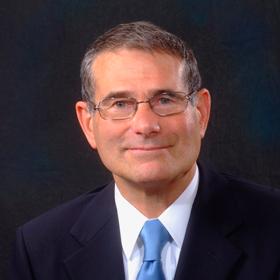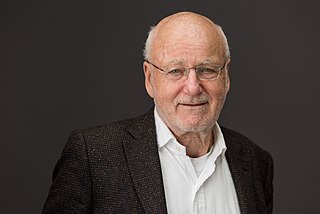Related Research Articles
Hematology is the branch of medicine concerned with the study of the cause,prognosis,treatment,and prevention of diseases related to blood. It involves treating diseases that affect the production of blood and its components,such as blood cells,hemoglobin,blood proteins,bone marrow,platelets,blood vessels,spleen,and the mechanism of coagulation. Such diseases might include hemophilia,sickle cell anemia,blood clots (thrombus),other bleeding disorders,and blood cancers such as leukemia,multiple myeloma,and lymphoma. The laboratory analysis of blood is frequently performed by a medical technologist or medical laboratory scientist.
William Dameshek was an American hematologist. He graduated from Harvard College and Harvard Medical School and spent the early part of his career at Beth Israel Hospital. He was the founder of Blood,the prime core clinical journal of hematology,in 1946. He is also credited with describing the concept of myeloproliferative diseases in 1951. In addition,he participated in the first studies of nitrogen mustard in various hematological malignancies,widely considered the first uses of chemotherapy in malignant diseases. Dr Dameshek was also the first one who described chronic lymphocytic leukemia (CLL),a common form of leukemia in adults.
Yuet Wai Kan,is a Chinese-American geneticist and hematologist. He is the current Louis K. Diamond Chair in Hematology and a Professor Emeritus at the University of California,San Francisco. He is a former president of the American Society of Hematology.
The American Society of Hematology (ASH) is a professional organization representing hematologists,founded in 1958. Its annual meeting is held in December of every year and has attracted more than 30,000 attendees. The society publishes the medical journal Blood,the most cited peer-reviewed publication in the field,and Blood Advances,an online,peer-reviewed open-access journal.
Slobodan Obradov was a Serbian physician. In the course of his professional career he has developed the hematology specialization in former Yugoslavia and aided in world class research on the subject of blood related cancers.

Helen Margaret Ranney was an American doctor and hematologist who made significant contributions to research on sickle-cell anemia.
Edward Shanbrom was an American medical researcher and hematologist,best known for the development of the process allowing the clotting protein Factor VIII to be made to treat hemophilia.
Edward J. Benz Jr. is the former president of Dana–Farber Cancer Institute in Boston,Massachusetts.,and the Richard and Susan Smith Professor of Medicine as well as a professor of genetics at Harvard Medical School.
Philip Steven Wells,M.D.,M.Sc.,FRCPC is a Canadian hematologist and current chair and Chief of Medicine at the University of Ottawa and The Ottawa Hospital. He is considered an expert in thromboembolic disorders and is known for developing the Wells risk score for pulmonary embolism and deep vein thrombosis.

Thomas P. Stossel was an American hematologist,inventor,medical researcher,and writer who discovered gelsolin and invented the BioAegis technology estate. He was also a professor emeritus of medicine at Harvard Medical School and a professor emeritus of clinical research at the American Cancer Society. He was Chief Scientific Advisor to BioAegis Therapeutics Inc.,a clinical-stage biotech company developing a non-immunosuppressive anti-inflammatory with the potential to address a wide range of infectious,inflammatory,and degenerative diseases.
Kenneth C. Anderson is an American hematologist-oncologist and cancer researcher who is primarily known for advances in the treatment of multiple myeloma. He directs the Lebow Institute for Myeloma Therapeutics and Jerome Lipper Myeloma Center at Dana–Farber Cancer Institute and is the Kraft Family Professor of Medicine and Vice Chair of the Joint Program in Transfusion Medicine at Harvard Medical School.
Bertha A. Bouroncle Pereny was a Peruvian-American hematologist. After completing medical school in Peru,Bouroncle came to the United States for her postgraduate medical training. A longtime member of the faculty at the Ohio State University College of Medicine,she was the first investigator to identify hairy cell leukemia and the first female full professor in the state of Ohio.
Scott Murphy was an American hematologist,medical researcher,and professor of medicine.
Howard Franklin Bunn is an American physician,hematologist and biochemist at Harvard Medical School,and a Fellow of the American Academy of Arts and Sciences. He is known for his co-discovery of glycated hemoglobin or A1C,a major diagnostic indicator of pre-diabetes and diabetes.

Mary Cushman is an American vascular hematologist. She is a Full professor of Medicine and Pathology in the Robert Larner College of Medicine at the University of Vermont.

Peter Marks is an American hematologist oncologist serving as the director of the Center for Biologics Evaluation and Research within the Food and Drug Administration. He was appointed to the position in 2016 after previously serving as deputy director.
Nancy J. Brown is an American physician-scientist. She is the Jean and David W. Wallace Dean and C.N.H. Long Professor of Internal Medicine at Yale University School of Medicine,having formerly served as the Hugh Jackson Morgan Professor of Medicine and Pharmacology,and Chair and Physician-in-Chief of the Department of Medicine at Vanderbilt University School of Medicine.
Jon Christopher Aster is an American pathologist who researches the role of the notch signaling pathway in leukemia. He is the Michael Gimbrone Professor of Pathology at Harvard Medical School. He has been a co-editor of the Annual Review of Pathology:Mechanisms of Disease since 2016.

Bob Löwenberg is a clinical hematologist/investigator. He is Professor of Hematology at Erasmus University Rotterdam.

Cynthia Dunbar is an American scientist and hematologist at the National Heart Lung and Blood Institute (NHLBI),which is part of the National Institutes of Health (NIH). She is the Branch Chief of the Translational Stem Cell Biology Branch.
References
- ↑ "Berliner, Nancy (Hematologist)". Library of Congress. Retrieved September 24, 2021.
- 1 2 "Wedding Planned For Dr. Berliner". The New York Times. October 28, 1984. Retrieved September 24, 2021.
- ↑ Berliner, Nancy (October 28, 2017). "Nancy Berliner Reflects on a Career Unscripted". The Hematologist. 14 (6). doi: 10.1182/hem.V14.6.7896 . Retrieved October 1, 2021.
- ↑ "Berliner Welcomed as Chief of Hematology". Brigham and Women's Hospital. November 10, 2006. Retrieved October 1, 2021.
- ↑ "Nancy Berliner". Yale University. Retrieved October 1, 2021.
- ↑ "BWH Honorees Named to Institute of Medicine". Brigham and Women’s Hospital. October 13, 2010. Retrieved October 1, 2020.
- ↑ "Berliner Named Inaugural Bunn Chair in Medicine". Brigham and Women’s Hospital. December 4, 2017. Retrieved October 1, 2021.
- ↑ "Nancy Berliner Steps in as Editor-in-Chief of Blood, First Industry Datasets Submitted to ASH Research Collaborative". ASH Clinical News. January 1, 2020. Retrieved October 1, 2021.